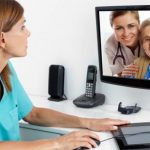 In the early months of the Covid pandemic strict social distancing rules meant that most primary care appointments moved onto telehealth platforms, either by telephone or over video chat. The process made what had been a gradual transition before Covid into an almost total transition overnight. Research from Syracuse University suggests that enthusiasm has endured a year on.
In the early months of the Covid pandemic strict social distancing rules meant that most primary care appointments moved onto telehealth platforms, either by telephone or over video chat. The process made what had been a gradual transition before Covid into an almost total transition overnight. Research from Syracuse University suggests that enthusiasm has endured a year on.
“We were surprised by the results,” the researchers say. “We initially thought that, because of the challenges of telehealth, physicians would not be in favor of continuing post-pandemic. It turns out they do. But make no mistake, there are challenges.”
One of the core challenges was with the technology itself, as both it and the supporting infrastructure require investment and training, both on the side of the physician and the patient. Despite this, there was general support for telehealth across the medical community.
Positive change
Research from the University of Oxford finds that no two implementations of telehealth are really the same, and while some have undoubtedly been highly efficient and effective, others have been cumbersome, inadequate, and loathed by patients.
The study found that telehealth consultations tend to be a poor fit for people who are either very young or very old, have a range of complex needs, need a physical examination, have a high-risk condition, lack the technology or privacy at home to use such services, or who have difficulty communicating via these platforms.
While going remote by default may, therefore, be adequate for relatively young people with fairly easy, one-off problems, the researchers believe this is scarcely the tip of the iceberg in terms of the overall body of cases seen by healthcare providers each year.
Using remote consultations for patients with a range of more complex needs, including mental as well as physical, is a considerable challenge. That’s not to say it’s impossible, of course, but it does require investment and reorganization of the healthcare system somewhat. For instance, receptionists and other people who perform triaging functions need to know how to route calls to the right professionals. Staff need to be trained to effectively use the technology. Note-taking needs to be factored in (or automated) so that the burden on doctors isn’t increased.
This will also need to ensure that face-to-face consultations remain an option for those for whom a video consultation is not sufficient. The study suggests that remote by default is not the way to go, but that with sufficient investment in infrastructure and training, it can be an increased presence in the healthcare mix for a wider range of people than the young and healthy that are its core market today.